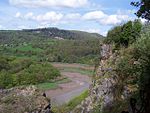Green Gathering
ChepstowCounterculture festivalsEnvironmental festivalsMusic festivals in SomersetMusic festivals in Wales ... and 2 more
Music festivals in WiltshireUse British English from June 2017

The Green Gathering, formerly known as the Big Green Gathering is a festival with an environmental and social justice focus, including workshops and talks on permaculture, politics, ecology and crafts, as well as art, live music and spoken word performances. The first Big Green Gathering was held in 1994 and the festival is currently held in Chepstow, Monmouthshire although it has previously been held in various locations in Somerset and Wiltshire, England.
Excerpt from the Wikipedia article Green Gathering (License: CC BY-SA 3.0, Authors, Images).Green Gathering
Footpath to Piercefield Park,
Geographical coordinates (GPS) Address Nearby Places Show on map
Geographical coordinates (GPS)
| Latitude | Longitude |
|---|---|
| N 51.658611111111 ° | E -2.6858333333333 ° |
Address
Footpath to Piercefield Park
Footpath to Piercefield Park
NP16 6BE , Chepstow
Wales, United Kingdom
Open on Google Maps










